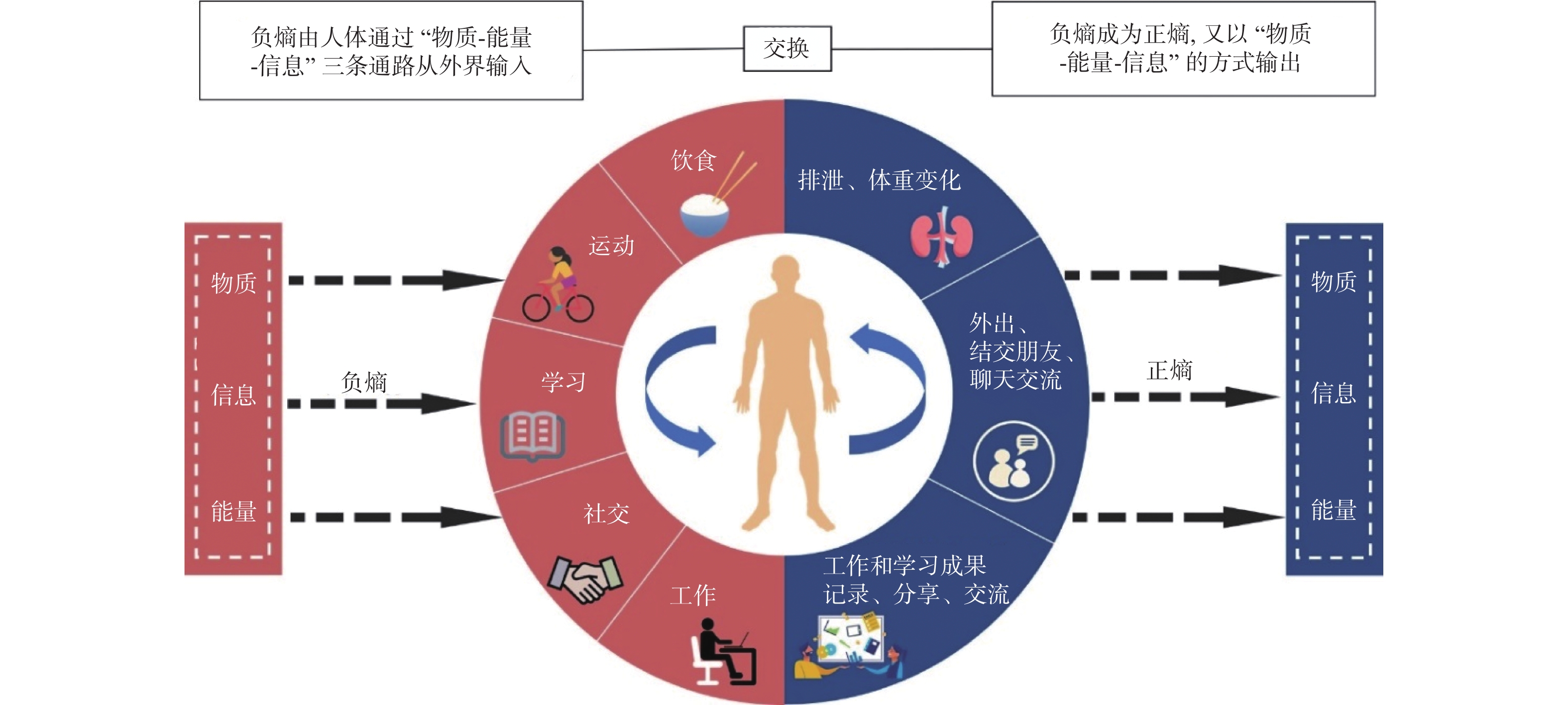-
摘要: 耗散结构是远离平衡态的非线性自组织有序结构,人体作为经典的耗散结构,通过与外界进行物质、能量、信息的充分交换产生负熵对抗“熵增”。系统梳理基于耗散结构与熵的理论和相关研究,探讨耗散结构理论对机体调节、癌症、衰老等的意义。选取孕产妇这一特殊人群,聚焦信息维度,开发了相应信息交换量表(Cronbach's α>0.9)并提出信息交换指数,初步探索耗散结构信息维度对孕期健康的影响,结果显示信息交换指数与孕期焦虑分数负相关(r =-0.35,P < 0.001),OR值为0.26(95%CI:0.08~0.80),初步证实了基于耗散结构理论开展实证研究的可行性。若能进一步开展相关实证研究,有望开发新的疾病预防策略,为公共卫生领域提供新理论和新方法。Abstract: Dissipative structure refers to a self-organized and orderly structure that exists far from equilibrium. The human body, considered a classical example, generates negative entropy through the exchange of matter, energy, and information with the environment to counteract the increase in entropy. In this paper, we organized theories and related research on dissipative structure and entropy, discussing their significance in regulating various aspects such as the human body, cancer, aging, and more. By selecting the special population of pregnant women, focusing on the information dimension, developing the corresponding information exchange scale (Cronbach's α > 0.9), and proposing the information exchange index, we preliminarily explored the influence of the dissipative structure's information dimension on pregnancy health. The results showed a negative correlation between the information exchange index and anxiety scores during pregnancy (r = -0.35, P < 0.001), with an OR value of 0.26 (95%CI: 0.08~0.80), preliminarily confirming the feasibility of conducting empirical research based on dissipative structure theory. If further relevant empirical studies are conducted, it is expected that new disease prevention strategies will be developed and new theories and methods will be provided for the field of public health.
-
Key words:
- Dissipative structure /
- Entropy /
- Health /
- Information exchange
-
表 1 耗散结构与生命现象(疾病、衰老等)相关研究梳理
Table 1. A compendium of research related to dissipative structures and life phenomena (disease,aging,etc.)
学者 主要观点 张海蓉等[14] 人是典型的耗散结构,生命以负熵为食,而玄府是维持人体耗散结构的关键,透玄排熵是治疗熵病的基本原则。 张宇叶等[16] 慢性疲劳综合征的病因机制与耗散结构理论极其吻合,从耗散结构出发可为该病的进一步探索寻求突破。 蔡振刚[17] 基于耗散结构,以中西医结合的方式恢复机体有序性,进行熵的量化有望推进乳腺癌远期的复发和转移的精准化治疗。 牛爱琴等[18] 人体是一个开放复杂的耗散结构。人体肿瘤(如妇科肿瘤)形成的原因在于环境因素(正熵的输入)导致基因发生突变产生不利于进化的表达。 崔珈铭等[19] 疾病发生必然伴随系统耗散和熵失衡,耗散结构和熵理论能够很好地解释暝眩现象及其机理并为临床诊疗提供参考。 Klimek R[20] 生物体的耗散状态是肿瘤发生的唯一常见原因,而肿瘤是一种自组织的生物耗散结构,因此肿瘤的治疗和预防应该关注环境。 Sabater B[21] 肿瘤细胞常常在没有分化的情况下偏离有序发育,因此肿瘤组织具有高熵。 Banerji C R等[15] 在乳腺癌和肺癌主要亚型当中,高熵肿瘤相较低熵肿瘤的危险率翻了一番。 吴伟光[22] 肿瘤在人体内的发生与扩散,打破了人体熵平衡循环状态,使人体熵值增加,熵增速率升高,生命周期缩短。 赵明蕊等[23-24] 人体衰老是必经过程,由于人体功能的衰退使机体与环境负熵的交换效能降低,使体内熵长期缓慢的增加,导致衰老。 Vallée A等[25] 阿尔兹海默症作为一种神经退行性疾病也被视为一种耗散结构,与周围环境交换能量、物质和信息效能降低,其异常的代谢和热力学失衡会导致熵增。 Zhang W等[1] 心理系统(思维)作为耗散结构,与外部和内部世界交换信息。当启用心理防御机制时,通过获得心理负熵或耗散自我呈现的能量来保持个体稳定和有序。 表 2 信息交换指数与孕期焦虑的单因素多因素分析
Table 2. Information exchange index and univariate-multivariate analysis of prenatal anxiety
变量 Model 1 Model 2 Model 3 OR (95%CI) OR (95%CI) OR (95%CI) 信息交换指数per (SD) 0.94 (0.91~0.98)*** 0.94 (0.90~0.98) ** 0.94 (0.89~0.99) ** 信息交换指数分组 < 10 Ref Ref Ref 10~20 0.79 (0.33~1.93) 0.66 (0.27~1.67) 0.67 (0.22~2.03) ≥20 0.27 (0.11~0.67) ** 0.25 (0.10~0.64) ** 0.26 (0.08~0.80) * *Model 1为单因素Logistic回归模型,Model 2校正了年龄,BMI,孕周,居住地,民族;Model 3校正了Model 2以及文化程度,婚姻状况,家庭年收入,职业,怀孕次数,本次受孕方式,宫内胎儿数目,孕前健康状况,是否无人照顾,孕早期吸烟,二手烟,吸烟史,饮酒史,劳动强度,每天的锻炼时间;OR:比值比;*P<0.05,**P<0.01,***P<0.001。 -
[1] Zhang W, Guo B Y. Resolving defence mechanisms: A perspective based on dissipative structure theory[J]. Int J Psychoanal,2017,98(2):457-472. doi: 10.1111/1745-8315.12623 [2] 孙艳英, 易小林, 孟燕军. 人体与熵[J]. 医学理论与实践,2004,17(3):249-250. doi: 10.3969/j.issn.1001-7585.2004.03.001 [3] Goldbeter A. Dissipative structures in biological systems: bistability, oscillations, spatial patterns and waves[J]. Philos Trans A Math Phys Eng Sci,2018,376(2124):20170376. [4] Prigogine I. Structure, dissipation and life[C]//Physique théorique et biologie (ed Marois), Amsterdam: North-Holland, 1969: 23-52. [5] 何萍芬, 岳小欣, 张长辉. 耗散结构理论及其在医学上的应用[J]. 中国组织工程研究与临床康复,2007,11(39):7999-8001. [6] Prigogine I, Nicolis G. Biological order, structure and instabilities[J]. Q Rev Biophys,1971,4(2-3):107-148. doi: 10.1017/S0033583500000615 [7] 吴祖仁, 吴江滨, 张增常, 等. 脑功能发育发展的动力学机制及其重要意义[J]. 湖北文理学院学报,2017,38(8):73-78. doi: 10.3969/j.issn.1009-2854.2017.08.013 [8] Chuprin V, Mihajlovic W. Three layer functional model and energy exchange concept of aging process[J]. Age (Dordr),2006,28(1):111-121. doi: 10.1007/s11357-005-4258-2 [9] 张岱, 金宝荣. 耗散结构与人体的熵变[C]//中国生物医学工程学会医学物理分会第十次学术年会、中华医学会医学工程学分会第一次医疗设备科学管理研讨会论文集, 中国北京, 1998: 118. [10] Wang Z G. The entropy perspective on human illness and aging[J]. Engineering,2022,9(2):22-26. [11] Seely A J. Optimizing our patients’ entropy production as therapy? Hypotheses originating from the physics of physiology[J]. Entropy,2020,22(10):1095. doi: 10.3390/e22101095 [12] 吴江滨, 吴祖仁, 陈培杰, 等. 开发教育的脑科学理论基础[J]. 湖北文理学院学报,2017,38(8):79-84,88. doi: 10.3969/j.issn.1009-2854.2017.08.014 [13] Collaborators IHME-CHAIN. Effects of education on adult mortality: A global systematic review and meta-analysis[J]. Lancet Public Health,2024,9(3):e155-e165. doi: 10.1016/S2468-2667(23)00306-7 [14] 张海蓉, 朱佩, 孙一珂, 等. 从玄府为人体耗散结构之基论治熵病[J]. 中华中医药杂志,2023,38(3):1061-1064. [15] Banerji C R, Severini S, Caldas C, et al. Intra-tumour signalling entropy determines clinical outcome in breast and lung cancer[J]. PLoS Comput Biol,2015,11(3):e1004115. doi: 10.1371/journal.pcbi.1004115 [16] 张宇叶, 武平, 王丹, 等. 基于耗散结构理论下慢性疲劳综合征病因病机相关性分析[J]. 辽宁中医药大学学报,2016,18(6):135-138. [17] 蔡振刚. 浅议基于耗散结构下的乳腺癌中西医结合治疗[J]. 医学争鸣,2017,8(6):46-48. [18] 牛爱琴, 刘绍光. 用耗散结构理论浅析妇科肿瘤的发生机制[J]. 医学与哲学,2005,26(22):37-39. [19] 崔珈铭, 李炜弘, 许嗣立, 等. 试用耗散结构理论、自组织及熵理论阐释中医疗效中暝眩现象的合理性[J]. 云南中医学院学报,2013,36(5):13-14. doi: 10.3969/j.issn.1000-2723.2013.05.005 [20] Klimek R. Cervical cancer as a natural phenomenon[J]. Eur J Obstet Gynecol Reprod Biol,1990,36(3):229-238. doi: 10.1016/0028-2243(90)90202-C [21] Sabater B. Entropy perspectives of molecular and evolutionary biology[J]. Int J Mol Sci,2022,23(8):4098. doi: 10.3390/ijms23084098 [22] 吴伟光. 熵与生命和肿瘤的关系[J]. 生命的化学,2001,21(6):531-533. doi: 10.3969/j.issn.1000-1336.2001.06.036 [23] 赵明蕊, 徐娜, 郭安齐. 熵理论对生命现象的研究[J]. 河南职工医学院学报,2012,24(3):357-358. [24] 赵明蕊, 张景亚, 王舒雨, 等. 熵理论解释限制能量摄入与延长寿命的关系[J]. 河南职工医学院学报,2012,24(5):719-721. [25] Vallée A, Lecarpentier Y, Guillevin R, et al. Reprogramming energetic metabolism in Alzheimer's disease[J]. Life Sci,2018,193(1):141-152. [26] Wen C P, Wai J P, Tsai M K, et al. Minimum amount of physical activity for reduced mortality and extended life expectancy: A prospective cohort study[J]. Lancet,2011,378(9798):1244-1253. doi: 10.1016/S0140-6736(11)60749-6 [27] Campos J C, Marchesi Bozi L H, Krum B, et al. Exercise preserves physical fitness during aging through AMPK and mitochondrial dynamics[J]. Proc Natl Acad Sci U S A,2023,120(2):e2204750120. doi: 10.1073/pnas.2204750120 [28] Jia J, Zhao T, Liu Z, et al. Association between healthy lifestyle and memory decline in older adults: 10 year, population based, prospective cohort study[J]. Bmj,2023,380(1):e072691. [29] Null G, Pennesi L. Diet and lifestyle intervention on chronic moderate to severe depression and anxiety and other chronic conditions[J]. Complement Ther Clin Pract,2017,29(1):189-193. [30] De Miguel Z, Khoury N, Betley M J, et al. Exercise plasma boosts memory and dampens brain inflammation via clusterin[J]. Nature,2021,600(7889):494-499. doi: 10.1038/s41586-021-04183-x [31] Berding K, Vlckova K, Marx W, et al. Diet and the microbiota-gut-brain axis: Sowing the seeds of good mental health[J]. Adv Nutr,2021,12(4):1239-1285. doi: 10.1093/advances/nmaa181 [32] Bremner J D, Moazzami K, Wittbrodt M T, et al. Diet, stress and mental health [J]. Nutrients, 2020, 12(8): 2428. [33] Yeung S S Y, Kwan M, Woo J. Healthy diet for healthy aging[J]. Nutrients,2021,13(12):4310. doi: 10.3390/nu13124310 [34] 马克思, 恩格斯. 马克思恩格斯选集: 第1卷 [M]. 北京: 人民出版社, 2012: 137-138. [35] Okui T. An analysis of health inequalities depending on educational level using nationally representative survey data in Japan, 2019[J]. BMC Public Health,2021,21(1):2242. doi: 10.1186/s12889-021-12368-2 [36] Johnson A E, Herbert B M, Stokes N, et al. Educational attainment, race, and ethnicity as predictors for Ideal cardiovascular health: From the national health and nutrition examination survey[J]. J Am Heart Assoc,2022,11(2):e023438. doi: 10.1161/JAHA.121.023438 [37] Gómez-Salgado J, Domínguez-Salas S, Romero-Martín M, et al. Work engagement and psychological distress of health professionals during the COVID-19 pandemic[J]. J Nurs Manag,2021,29(5):1016-1025. doi: 10.1111/jonm.13239 [38] Watanabe M, Yamauchi K. The effect of quality of overtime work on nurses' mental health and work engagement[J]. J Nurs Manag,2018,26(6):679-688. doi: 10.1111/jonm.12595 -






 下载:
下载:




